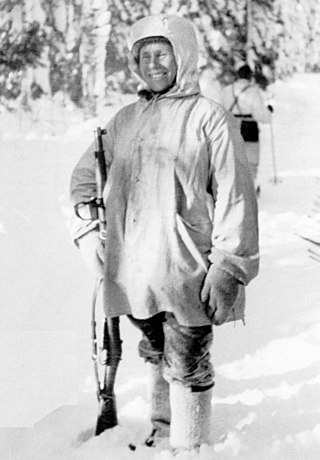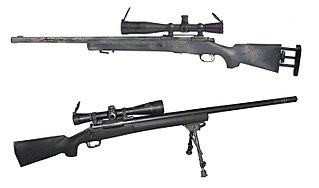Related Research Articles

A firearm is any type of gun that uses an explosive charge and is designed to be readily carried and used by an individual. The term is legally defined further in different countries.

A sniper is a military/paramilitary marksman who engages targets from positions of concealment or at distances exceeding the target's detection capabilities. Snipers generally have specialized training and are equipped with high-precision rifles and high-magnification optics, and often also serve as scouts/observers feeding tactical information back to their units or command headquarters.

Bolt-action is a type of manual firearm action that is operated by directly manipulating the bolt via a bolt handle, which is most commonly placed on the right-hand side of the firearm.

Enemy at the Gates is a 2001 war film directed, co-written, and produced by Jean-Jacques Annaud, based on William Craig's 1973 nonfiction book Enemy at the Gates: The Battle for Stalingrad, which describes the events surrounding the Battle of Stalingrad in the winter of 1942–1943. The screenplay was written by Annaud and Alain Godard. The film's main character is a fictionalized version of Vasily Zaitsev, a sniper and Hero of the Soviet Union during World War II. It includes a snipers' duel between Zaitsev and a Wehrmacht sniper school director, Major Erwin König.

Simo Häyhä, often referred to by his nickname, The White Death, was a Finnish military sniper in World War II during the 1939–1940 Winter War against the Soviet Union. He used a Finnish-produced M/28-30 and a Suomi KP/-31 submachine gun. He is believed to have killed over 500 enemy soldiers during the Winter War, the highest number of sniper kills in any major war. Because of this, he is often regarded as the deadliest sniper of all time.

A ghillie suit is a type of camouflage clothing designed to resemble the background environment - such as foliage, snow or sand. Typically, it is a net or cloth garment covered in loose strips of burlap (hessian), cloth, or twine, sometimes made to look like leaves and twigs, and optionally augmented with scraps of foliage from the area.

A sniper rifle is a high-precision, long-range rifle. Requirements include high accuracy, reliability, and mobility, concealment, and optics, for anti-personnel, anti-materiel and surveillance uses by military snipers. The modern sniper rifle is a portable shoulder-fired rifle with either a bolt action or semi-automatic action, fitted with a telescopic sight for extreme accuracy and chambered for a high-ballistic performance centerfire cartridge.
Carlos Norman Hathcock II was a United States Marine Corps (USMC) sniper with a service record of 93 confirmed kills. Hathcock's record and the extraordinary details of the missions he undertook made him a legend in the U.S. Marine Corps. He was honored by having a rifle named after him: a variant of the M21 dubbed the Springfield Armory M25 White Feather, for the nickname "White Feather" given to Hathcock by the North Vietnamese People's Army of Vietnam (PAVN).
A sniper is a military or police member or civilian who shoot targets, humans or animals at long ranges using rifles equipped with telescopic sights.

Lyudmila Mikhailovna Pavlichenko was a Soviet sniper in the Red Army during World War II. She is credited with killing 309 enemy combatants. She served in the Red Army during the siege of Odessa and the siege of Sevastopol, during the early stages of the fighting on the Eastern Front. Her score of 309 kills likely places her within the top five snipers of all time, but her kills are likely much more numerous, as a confirmed kill has to be witnessed by a third party.

The Barrett M82 is a recoil-operated, semi-automatic anti-materiel rifle developed by the American company Barrett Firearms Manufacturing.

The Rifle, .303 Pattern 1914 was a British service rifle of the First World War period, principally manufactured under contract by companies in the United States. It was a bolt-action weapon with an integral 5-round magazine. It served as a sniper rifle and as second-line and reserve issue, until declared obsolete in 1947. The Pattern 1914 Enfield was the successor to the Pattern 1913 Enfield experimental rifle and the predecessor of the U.S. Rifle M1917 Enfield.
This is a chronology of activities by the Provisional Irish Republican Army (IRA) from 1970 to 1979.
William Dixon Cocker was a Scottish poet who wrote in both Scots and English.

The U.S. Army Sniper Course trains selected military members assigned to sniper positions in the skills necessary to deliver long-range precision fire and the collection of battlefield information. Students will receive training in fieldcraft skills, advanced camouflage techniques, concealed movement, target detection, range estimation, terrain utilization, intelligence preparation of the battlefield (IPB), relevant reporting procedures, sniper tactics, advanced marksmanship, and staff subjects.

The South Armagh Sniper is the generic name given to the members of the Provisional Irish Republican Army's (IRA) South Armagh Brigade who conducted a sniping campaign against the British Army from 1990 to 1997. The campaign is notable for the snipers' use of .50 BMG calibre Barrett M82 and M90 long-range rifles in some of the shootings.
"The Ballad of East and West" is a poem by Rudyard Kipling. It was first published in 1889, and has been much collected and anthologized since.

The Enfield No. 2 was a British top-break revolver using the .38 S&W round manufactured from 1930 to 1957. It was the standard British/Commonwealth sidearm in the Second World War, alongside the Webley Mk IV and Smith & Wesson Victory Model revolvers chambered in the same calibre. Note that in the context of British service revolvers, the .38 S&W cartridge has often been called ".380".

Spring is a lyric poem written and illustrated by William Blake. It was first published in Songs of Innocence (1789) and later in Songs of Innocence and Experience (1794).

Semyon Danilovich Nomokonov was a Soviet sniper during World War II credited with 367 kills. An ethnic Hamnigan Evenk, Nomokonov was among the indigenous peoples of Russia who fought in the war. He received the nickname "Taiga Shaman" from enemies.